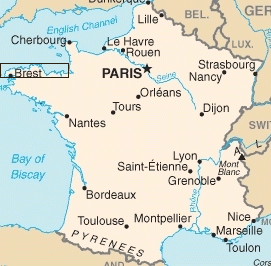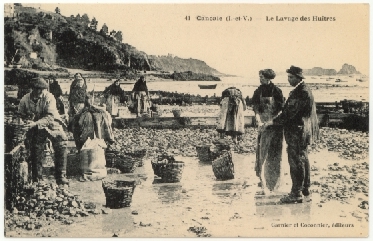Oysters of Northern Brittany
John McCabe
In terms of oysters, the coastal area of northern Brittany starts
around the famous cloister Mont Saint Michel and stretches
all the way to the City of Brest. The most significant
cultivation areas in this stretch of coast are located in Cancale,
St-Brieuc, Carantec, Paimpol, Tréguier,
the Bay of Morlaix, Les Abers ("the little
Fjords"), and the waters around Brest.
 Not far from the famous cloister Mont-Saint-Michel,
there is a little coastal town called Cancale. Although
Cancale might be considered fairly small as towns go, it is a
giant town when it comes to oysters. Considered by many oyster
lovers "the true oyster capital of the world", it is,
at the very least, most certainly the oyster capital of all of
Brittany. This is where Louis XIV., often remembered as the "sun
king", usually preferred to order his oysters. Riders on
fast horses would deliver his fresh oysters directly to his royal
palace, Versailles. Today, many of the finest restaurants
in Paris insist on oysters only from Cancale. The town is loaded
with lots of quaint little restaurants. Excellent food is served
there. This area is famous not only for its oysters, but also
for superb lamb dishes and an array of fine wines. Down at the
Bay of Cancale, an oyster lover is welcomed by a good number
of oyster vendors, offering copious amounts of fresh oysters
to the general public at reasonable prices. Whatever an oyster
lover's heart might desire, at least one of the vendors will
have it. Pacific oysters ("Creuses") are available
in any size, from little "slurpers" right on up to
the so called "Sauvages", the "wild ones",
which designates huge Pacific oysters. They are unsuitable for
slurping off the half shell, as they would choke the proverbial
horse (hence only suited for cooking). European oysters are also
available. Historically, European oysters ("Plates")
are Brittany's claim to fame. Even so called "Pied de Cheval"
can be bought. These are big European oysters that somehow managed
to to live to a ripe old age. They were overlooked by harvesters
for years and spared the ravages of oyster diseases. Despite
their age, they are most tender and highly tasty. The meat of
oysters does not get "tough" with age - it just gets
bigger. The vendors down by the water will gladly open any oyster
for a small fee. Oyster lovers can then walk off with their plastic
plate full of fresh oysters - ready to be slurped on a bench
or sitting on a low wall overlooking the bay. Heaven!
Not far from the famous cloister Mont-Saint-Michel,
there is a little coastal town called Cancale. Although
Cancale might be considered fairly small as towns go, it is a
giant town when it comes to oysters. Considered by many oyster
lovers "the true oyster capital of the world", it is,
at the very least, most certainly the oyster capital of all of
Brittany. This is where Louis XIV., often remembered as the "sun
king", usually preferred to order his oysters. Riders on
fast horses would deliver his fresh oysters directly to his royal
palace, Versailles. Today, many of the finest restaurants
in Paris insist on oysters only from Cancale. The town is loaded
with lots of quaint little restaurants. Excellent food is served
there. This area is famous not only for its oysters, but also
for superb lamb dishes and an array of fine wines. Down at the
Bay of Cancale, an oyster lover is welcomed by a good number
of oyster vendors, offering copious amounts of fresh oysters
to the general public at reasonable prices. Whatever an oyster
lover's heart might desire, at least one of the vendors will
have it. Pacific oysters ("Creuses") are available
in any size, from little "slurpers" right on up to
the so called "Sauvages", the "wild ones",
which designates huge Pacific oysters. They are unsuitable for
slurping off the half shell, as they would choke the proverbial
horse (hence only suited for cooking). European oysters are also
available. Historically, European oysters ("Plates")
are Brittany's claim to fame. Even so called "Pied de Cheval"
can be bought. These are big European oysters that somehow managed
to to live to a ripe old age. They were overlooked by harvesters
for years and spared the ravages of oyster diseases. Despite
their age, they are most tender and highly tasty. The meat of
oysters does not get "tough" with age - it just gets
bigger. The vendors down by the water will gladly open any oyster
for a small fee. Oyster lovers can then walk off with their plastic
plate full of fresh oysters - ready to be slurped on a bench
or sitting on a low wall overlooking the bay. Heaven!
 Image: A post card from the early 20th century
depicting oystermen and women tending to their oysters. It is
titled "Le Lavage des Huîtres" ("The washing
of oysters."). Looks like some potential buyers may have
arrived. Please note the boarded perimeter of each holding area
in the inter-tidal zone, another form of "claires".
Click to enlarge.
Image: A post card from the early 20th century
depicting oystermen and women tending to their oysters. It is
titled "Le Lavage des Huîtres" ("The washing
of oysters."). Looks like some potential buyers may have
arrived. Please note the boarded perimeter of each holding area
in the inter-tidal zone, another form of "claires".
Click to enlarge.
The oyster cultivation area of Cancale
is enormous. Tidally it is also quite unique. At approx. 30 feet,
it has one of the largest tidal mean ranges in the world. This
translates into most active tidal flow, carrying nutrients past
the hungry "mouths" of countless oysters almost continuously.
Besides the cultivation of Pacific oysters
in the inter-tidal zone, many growers also cultivate European
oysters in the sub-tidal zone. At a depth of anywhere from 10
to 40 feet, they are grown either on the ocean bottom (traditional
bottom cultivation) or suspended in plastic cages (modern suspended
cultivation). Whatever European oyster cultivation method is
chosen, it is always associated with high costs (and great risks)
for the growers. First, young (seed) oysters (so called Naissins)
are procured either from marine laboratories or natural collectors.
The young oysters are then spread in a designated marine plot
(or placed in the suspended cages). Unlike the Pacific oyster,
the European oyster grows more slowly, commanding an extra year
or two to reach marketable size. Much can happen to the grower's
European oysters during this time. If he is growing them on the
ocean floor, a storm might pick up and shift some (or all) of
his stock to some place unknown. The European oyster is also
highly susceptible to (at least) two serious oyster diseases
(Martellia refringens, Bonamia ostrea). Bottom cultivators thus
rotate their growing areas. Areas, where an oyster disease has
struck, are generally quarantined for a few seasons. The growers
also watch the density of the oyster seed in a particular plot.
High density would aid the rapid spread of an oyster disease
and could also create an excessively competitive environment
for available nutrients.


